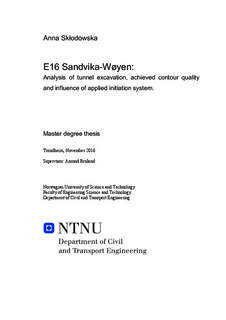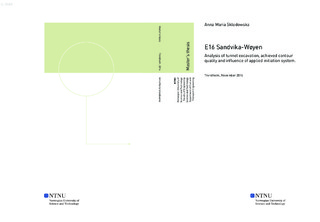| dc.description.abstract | The drill and blast excavation method is the most commonly used method for tunnel construction in Norway. In D&B the results from blasting can be evaluated through several factors, such as pull percentage, vibration level and contour quality.
The main goal of the thesis was to analyze excavation with a special focus on the quality of the achieved contour and the influence of the applied initiation system. The analysis was performed based on results from the Bjørnegård tunnel, which was a part of the E16 Sandvika-Wøyen, Norwegian infrastructural project. Tunnel excavation analysis was done by an estimation of the drilling accuracy and measurement results from scanning. Data for the thesis was collected from one tunnel tube from twelve rounds in total: seven of which used standard non-electric detonators and five used electronic detonators. The assumption was that the use of the electronic detonators as an initiation system has the potential for better contour quality. Special accuracy of the drilling was required for the test.
The analysis was divided into two parts. The first part was focused on the analysis of drilling accuracy. For the evaluation of the results, MWD data from the drilling jumbo was used. Local coordinates from the drilling rig were used for the estimation of the spacing and length of the drilling holes, while global coordinates were used for the start and end position of the holes in comparison to the theoretical contour.
The second part focused on the analysis of the results from the tunnel scanning, which provided information about theoretical and actual contour length, theoretical and overblast area and distances from the theoretical to the actually blasted contour. Scanning analysis was based on an evaluation of the ratio of actual contour length to planned contour length (RCL), ratio of actual blasted to planned area(RBA), overbreak and Tunnel Contour Quality Index (TCI).
Analysis of the drilling results showed no significant difference between the accuracy of the drilling in the non-electric rounds compared to the test rounds. Estimation of the spacing and length of the contour holes presented a difference of 1% and 3% respectively. Results of the calculation of the starting position of the holes indicated a decrease of the accuracy of the placement of the hole in accordance to the theoretical profile. The special requirement of a maximum 10 cm distance from the theoretical contour of the starting position of the holes was fulfilled for 13% of the holes drilled in the test rounds.
Evaluation of the scanning results showed that results from non-electric and electronic detonators rounds were similar, and no improvement of the tunnel quality was calculated. Tunnel Contour Quality Index (TCI) for both data sets was similar and estimated as average. | |

